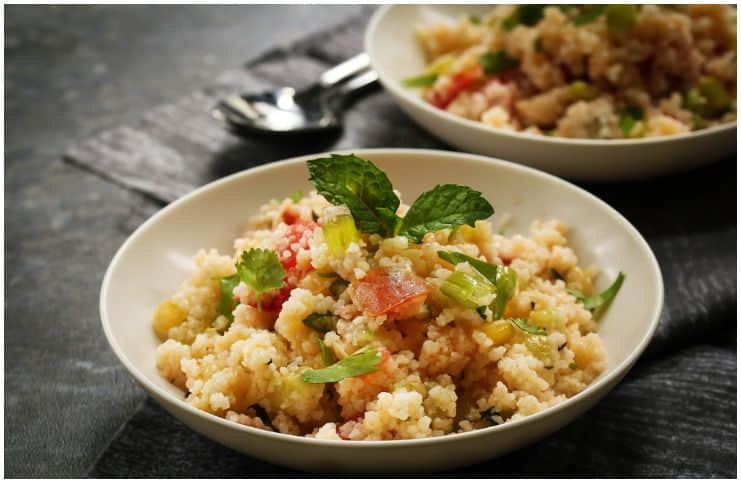Couscous
It is a popular side dish (made from steamed balls of crushed durum wheat semolina), especially in Middle Eastern and North African cuisine.
This food takes on the taste of the other ingredients and doesn’t have a strong flavor. It is frequently called a grain, but it is technically pasta.
Nutrition Facts
It is a good source of protein, selenium, thiamin, niacin, pantothenic acid, folate, and manganese. Also, one cup has about 36 grams of carbohydrates, 176 calories, and 2 grams of dietary fiber.
Health Benefits
A Good Source Of Protein
Protein is made up of units called amino acids and has a vital role in almost all biological processes. For instance, protein aids in the transport of a variety of substances throughout the body, replace worn-out cells, and helps in repair and growth. Moreover, protein is used to make antibodies that fight disease.
100g of this pasta has 3,8g protein which is about 8 percent of the daily recommended intake.
Increases Satiety
Dietary fiber is similar to sugars and starches in that it is primarily made of carbohydrates. Fiber is actually the indigestible parts or compounds of plants, that pass unchanged through the human intestines and stomach.
However, having a regular diet rich in fiber helps prevent constipation. Moreover, it is useful for the treatment (and prevention) of type 2 diabetes mellitus, diverticulosis, and heart disease. Also, since it makes you feel full faster, food high in fiber can help with weight control.
100g of this pasta has 1,4g dietary fiber, which is approximately 6 percent of the daily recommended intake.
Antioxidant Properties
Selenium is an essential component of two antioxidant enzymes that are produced by the body, thioredoxin, which recycles vitamin C, and glutathione peroxidase, which recycles glutathione.
Selenium also has a cardioprotective benefit by preventing the oxidative modification of lipids (fats), hence, preventing aggregation of platelets in the arteries and lowering inflammation.
A deficiency of selenium is linked to an increased risk of thyroid cancer (there are more than 56,000 new cases of this type of cancer in the United States per year) because of its important role in protecting the thyroid gland from damage.
100g of this pasta has 27,5mcg selenium which is 39 percent of the daily recommended intake.
Prevents Depression
Niacin, better known as vitamin B3, is an essential nutrient found in many foods, including – kidney beans, peanuts, broccoli, and mushrooms. This vitamin is highly effective at increasing HDL as well as reducing LDL cholesterol and triglycerides.
Furthermore, vitamin B3 is required for a well-functioning digestive system and a healthy nervous system. Also, according to research, niacin aids in the energy production of cells.
Vitamin B3 deficiency usually affects the digestive system, skin (sensitivity to sunlight and red lesions), and mental functioning. 100g of this food has 1mg niacin which is 5 percent of the daily recommended intake.
Side Effects
There are no scientifically proven side effects.
Brown Rice
It has been a staple crop across much of Asia for millennia. Even in the present day, it provides more than 20 percent of total available calories in the world.
This food is the whole rice grain with just the first outer layer removed through milling. Therefore, it retains most of its dietary fiber and germ that contains vital nutrients.
Nutrition Facts
It is an excellent source of selenium, zinc, manganese, copper, magnesium, phosphorus, vitamin B6, niacin, dietary fiber, and protein. Also, it doesn’t contain cholesterol, saturated fats, trans fats, and sodium.
Health Benefits
Bone Health
As a vital component in numerous biochemical reactions occurring non-stop within the human body, magnesium is an essential mineral in the health of the human body.
In addition, magnesium helps the human body absorb vitamin D better, which is vital to bone health as well as it aids the bones to better absorb the calcium they require. 100g of this whole food has 43 mg of magnesium that is approximately 11 percent of the daily recommended intake.
Boosts Collagen Production
Manganese is a trace mineral present in all living beings. It is an important factor in reproduction, cellular energy, and regulation of the levels of blood sugar (glucose) and calcium in the body.
It is also involved in the development and formation of tissues and bones, collagen, RNA and DNA, blood-clotting factors, and sex hormones.
100g of this grain has 0,9 mg manganese that is about 45 percent of the daily recommended intake.
Fights Free Radicals
Selenium is an essential mineral that is necessary to human health but only in very small quantities. For example, selenium protects the body against many degenerative diseases, like – emphysema, hardening of the arteries (better known as atherosclerosis), cataracts, liver cirrhosis, arthritis, and heart attack.
Selenium is also an important part of the enzyme glutathione peroxidase which works with vitamins E and C to neutralize free radicals. 100g of these grains have 9,8 mcg of selenium that is 14 percent of the daily recommended intake.
Side Effects
To avoid contamination with mold, arsenic, and bacteria, only purchase organic, non-GMO rice. There are no other scientifically proven side effects.
Couscous vs Rice – Which Has A Better Nutritional Profile?
Both these foods should be included in your regular diet, however, brown rice is the winner, mainly due to its higher content of manganese, magnesium, phosphorus, and thiamin.
Images credit – Shutterstock
READ THIS NEXT: Quinoa vs Lentils
